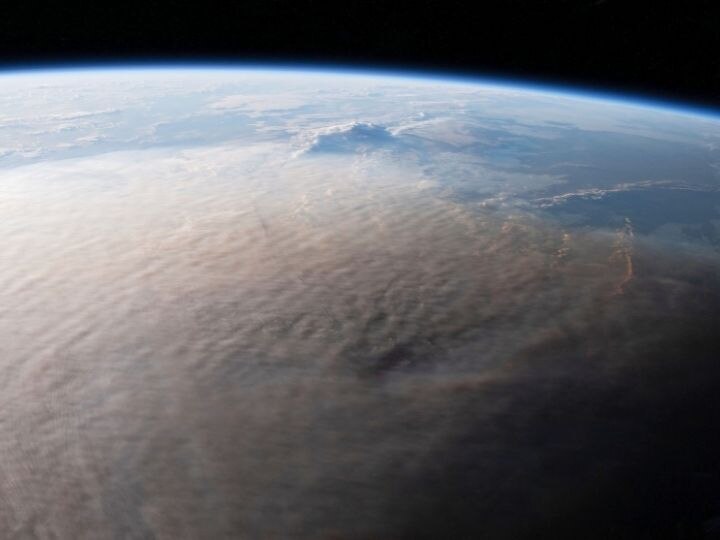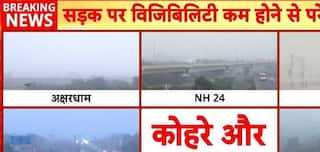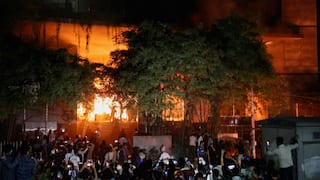Explorer
Tonga Eruption Equivalent To Hundreds Of Hiroshimas, All Of New Land Gone: NASA
The Tonga eruption released hundreds of times the equivalent mechanical energy of the Hiroshima nuclear explosion in August 1945, NASA has said.

Hunga Tonga-Hunga Ha’apai volcano in 2015 (top left); aerial view on January 18, 2022 after the January 15 eruption (bottom left) (Credit: Mary Lyn FONUA / Defence Public Affairs / AFP); Destroyed island after the Tonga eruption (right) (Credit: Satellite image ©2022 Maxar Technologies / AFP)
New Delhi: An explosive eruption of the Hunga Tonga-Hunga Ha'apai volcano on January 15 triggerred a tsunami in the south Pacific ocean. The underwater volcano, also called a submarine volcano, is located near the Kingdom of Tonga, an archipelago of nearly 170 islands.
 Blast Equivalent To Hundreds Of Hiroshimas
Blast Equivalent To Hundreds Of Hiroshimas
James Garvin, chief scientist at NASA’s Goddard Space Flight Center in Greenbelt, Maryland, US, said that researchers estimate the amount of energy released by the eruption to be equivalent to somewhere between four to eight megatons of Trinitrotoluene (TNT), according to an article published by NASA's Earth Observatory. The blast released hundreds of times the equivalent mechanical energy of the Hiroshima nuclear explosion in August 1945, NASA said on its website.
Scientists estimate that Mount St. Helens exploded in 1980 with 24 megatons and Krakatoa burst in 1833 with 200 megatons of energy.
Garvin added that the number is based on how much was removed, how resistant the rock was, and how high the eruption clouds were blown into the atmosphere at a range of velocities.
Scientists estimate that Mount St. Helens exploded in 1980 with 24 megatons and Krakatoa burst in 1833 with 200 megatons of energy.
Garvin added that the number is based on how much was removed, how resistant the rock was, and how high the eruption clouds were blown into the atmosphere at a range of velocities.
ALSO READ: Undersea Volcano Not Unique To Tonga. See Where Submarine Volcanoes Are Found, Timeline Of Past Eruptions
Before the violet explosion that occurred in January, another eruption had occurred on December 20, 2021. The Tonga eruption was seven times more powerful than the previous eruption.
Before the violet explosion that occurred in January, another eruption had occurred on December 20, 2021. The Tonga eruption was seven times more powerful than the previous eruption.
A series of small eruptions had begun in December, and these increased the size of the island, according to a Nature article.
Garvin and an international team of researchers have been monitoring changes at Hunga Tonga-Hunga Ha'apai, ever since new land rose above the water surface in 2015 and joined two existing islands.
Using a combination of satellite observations and surface-based geophysical surveys, the team tracked the evolution of the rapidly changing piece of Earth, NASA said on its website.
The Hunga Tonga-Hunga Ha'apai, the uppermost part of the large underwater volcano in Tonga, rose 1.8 kilometres above the seafloor, stretched 20 kilometres across, and was topped by a submarine caldera (large depression formed when a volcano erupts and collapses).
The Hunga Tonga-Hunga Ha'apai, the uppermost part of the large underwater volcano in Tonga, rose 1.8 kilometres above the seafloor, stretched 20 kilometres across, and was topped by a submarine caldera (large depression formed when a volcano erupts and collapses).
All Of The New Land Is Gone After The Violent Eruption
The island was the only part of the edifice that stood above water. After the violent explosion, all of the new land is gone, along with large chunks of the two older islands, according to NASA.
A series of violent eruptions in early 2022 obliterated the island. By January 17, all that remained were two small landmasses, once again separated by the sea.
In order to develop detailed maps of Hunga Tonga-Hunga Ha'apai above and below the water line, Garvin and his NASA colleague Dan Slayback worked with several researchers.
Garvin said he and his team of researchers were in the process of submitting a paper describing the island's slow erosion and a theoretical model for what makes it so stable, but had to "hit reset" because of the violent eruption, according to the Nature article.
Optical, radar, and laser satellites are being used by researchers around the world to monitor what is left of the island.
Garvin said that the International Space Station's Global Ecosystem Dynamics Investigation instrument has also collected data, the Nature article stated.
Dramatic Changes To The Volcanic Island After The Tonga Eruption
Things changed dramatically after the Tonga eruption. The volcanic activity seemed typical enough for the first few weeks of 2022, according to NASA.
There were intermittent, small explosions of tephra (all fragments of rock ejected into the air by an erupting volcano), ash, steam, and other volcanic gases as the magma and seawater interacted at a vent near the middle of the island.
The land was being reshaped due to the ongoing Surtseyan eruptions, which are an explosive style of volcanic eruption occurring in shallow seas or lakes due to the explosive interaction of rapidly rising hot magma with water.
A series of violent eruptions in early 2022 obliterated the island. By January 17, all that remained were two small landmasses, once again separated by the sea.
In order to develop detailed maps of Hunga Tonga-Hunga Ha'apai above and below the water line, Garvin and his NASA colleague Dan Slayback worked with several researchers.
Garvin said he and his team of researchers were in the process of submitting a paper describing the island's slow erosion and a theoretical model for what makes it so stable, but had to "hit reset" because of the violent eruption, according to the Nature article.
Optical, radar, and laser satellites are being used by researchers around the world to monitor what is left of the island.
Garvin said that the International Space Station's Global Ecosystem Dynamics Investigation instrument has also collected data, the Nature article stated.
Dramatic Changes To The Volcanic Island After The Tonga Eruption
Things changed dramatically after the Tonga eruption. The volcanic activity seemed typical enough for the first few weeks of 2022, according to NASA.
There were intermittent, small explosions of tephra (all fragments of rock ejected into the air by an erupting volcano), ash, steam, and other volcanic gases as the magma and seawater interacted at a vent near the middle of the island.
The land was being reshaped due to the ongoing Surtseyan eruptions, which are an explosive style of volcanic eruption occurring in shallow seas or lakes due to the explosive interaction of rapidly rising hot magma with water.
Surtsey is a volcanic island that formed near Iceland by volcanic eruptions that took place from 1963 to 1967. It still exists more than half a century later.
ALSO READ: Tonga Tsunami: What Are Submarine Or Undersea Volcanoes & How They Erupt | EXPLAINED
The Surtseyan eruptions were adding new deposits of ash and tuff to the growing volcanic cone in Tonga.
Quoting Garvin, the Earth Observatory article said that the researchers' data, by early January, showed that the island had expanded by about 60 per cent compared to before the December activity started.
He added that the whole island had been completely covered by a tenth of a cubic kilometre of new ash, and that all of this was pretty normal, expected behaviour, and very exciting to their team.
However, on January 13-14, an unusually powerful set of blasts sent ash surging into the stratosphere, the article said.
Subsequent explosions on January 15 launched material as high as 40 kilometres in altitude and possibly as high as 50 kilometres. The explosions blanketed nearby islands with ash and triggered destructive tsunami waves.
An astronaut above the International Space Station took a picture of ash over the South Pacific.
The Surtseyan eruptions were adding new deposits of ash and tuff to the growing volcanic cone in Tonga.
Quoting Garvin, the Earth Observatory article said that the researchers' data, by early January, showed that the island had expanded by about 60 per cent compared to before the December activity started.
He added that the whole island had been completely covered by a tenth of a cubic kilometre of new ash, and that all of this was pretty normal, expected behaviour, and very exciting to their team.
However, on January 13-14, an unusually powerful set of blasts sent ash surging into the stratosphere, the article said.
Subsequent explosions on January 15 launched material as high as 40 kilometres in altitude and possibly as high as 50 kilometres. The explosions blanketed nearby islands with ash and triggered destructive tsunami waves.
An astronaut above the International Space Station took a picture of ash over the South Pacific.

In most Surtseyan style eruptions, a relatively small amount of water comes into contact with magma. Garvin explained that if there is just a little water trickling into the magma, it is like water hitting a hot frying pan, according to the article.
He said that what happened on January 15 was really different, and the researchers do not know the reason because they do not have seismometers on Hunga Tonga-Hunga Ha'apai.
He added that something must have weakened the hard rock in the foundation and caused a partial collapse of the caldera's northern rim.
ALSO READ: Tonga Eruption: NASA Space Scientists Study Submarine Volcano To Understand Landforms On Mars, Venus
He said that the phenomenon can be thought of as the bottom of the pan dropping out, allowing huge amounts of water to rush into an underground magma chamber at very high temperature, according to the article.
While seawater temperature is closer to 20 degrees Celsius, the temperature of magma usually exceeds 1000 degrees Celsius.
The mixing of magma and water can be incredibly explosive, particularly in the confined space of a magma chamber, NASA said on its website.
Garvin explained that this was not the standard Surtseyan eruption because of the large amount of water that had to be involved. He said that some of his colleagues in volcanology think that this type of event deserves its own designation, and that for now, they are unofficially calling it an 'ultra Surtseyan' eruption. Apart from Surtsey in Iceland, most new Surtseyan islands get eroded away within a few months or years.
He said that the phenomenon can be thought of as the bottom of the pan dropping out, allowing huge amounts of water to rush into an underground magma chamber at very high temperature, according to the article.
While seawater temperature is closer to 20 degrees Celsius, the temperature of magma usually exceeds 1000 degrees Celsius.
The mixing of magma and water can be incredibly explosive, particularly in the confined space of a magma chamber, NASA said on its website.
Garvin explained that this was not the standard Surtseyan eruption because of the large amount of water that had to be involved. He said that some of his colleagues in volcanology think that this type of event deserves its own designation, and that for now, they are unofficially calling it an 'ultra Surtseyan' eruption. Apart from Surtsey in Iceland, most new Surtseyan islands get eroded away within a few months or years.
Quoting Daniel Slayback, a geographer at the Goddard Space Flight Center, the Nature article said that the vast majority of the island is now gone, and that it is kind of shocking to see. He has visited the Hunga Tonga-Hunga Ha'apai. He said: "It's pretty dynamic".
Magma Under Earth's Crust May Create Another Island
The Nature article said that Garvin is hopeful of the fact that the giant chamber of magma deep under Earth's crust that formed Hunga Tonga-Hunga Ha'apai will eventually create another island for researchers to study.
Quoting Garvin, the Nature article, Garvin said that if the magma creates another island, the researchers will measure it, and build a story about it.
Quoting Garvin, the Nature article, Garvin said that if the magma creates another island, the researchers will measure it, and build a story about it.
Follow Science News on ABP Live for more latest stories and trending topics. Watch breaking news and top headlines online on ABP News LIVE TV
Read more







































